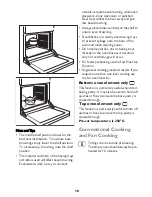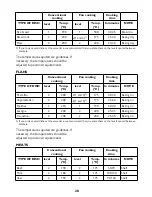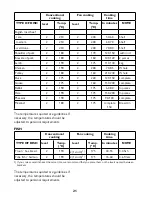
Electrical Connections
Warning!
THIS OVEN MUST BE
EARTHED
Electrical Requirements
Any permanent electrical installation must
comply with the latest I.E.E. Regulations and
local Electricity Board regulations. For your
own safety this should be undertaken by a
qualified electrician, e.g. your local Electricity
Board, or a contractor who is on the roll of
the National Inspection Council for Electrical
Installation Contracting (NICEIC).
Electrical Connection
The oven is designed to be connected to 230
V ~ 50 Hz electricity supply.
Before connecting to the mains supply ensure
that the mains voltage corresponds to the
voltage on the rating plate on the side of the
oven door.
The oven has an easily accessible terminal
block which is marked as follows:
Letter L - Live terminal
Letter N - Neutral terminal
- Earth terminal
Caution!
This oven must be earthed!
The cable used to connect the oven to the
electrical supply must comply to the
specifications given below.
For UK use only
Connection via
Min. size Cable/flex
Cable/flex type
Fuse
• 13 A socket outlet
• 13 A spur box
2,5 mm²
3 core butyl insulated
13 A min.
Oven Control Circuit
2,5 mm²
PVC/PVC twin and earth
min: 15 A
max: 20 A
It is necessary that you install a double pole
switch between the oven and the electricity
supply (mains), with a minimum gap of 3 mm
between the switch contacts and of a type
suitable for the required load in compliance
with the current regulations.
Warning!
The switch must not break
the yellow and green earth cable at any
point.
It is necessary that the yellow/green
earth wire is about 2 cm longer than
the live and neutral ones.
Important!
After installation and
connecting, the cable must be placed so that
it cannot at any point reach a temperature of
more than 60°C above the ambient
temperature.
Before the oven is connected, check that the
main fuse and the domestic installation can
support the load; and that the power supply
is properly earthed.
The manufacturer declines any
responsibility should these safety
measures not be carried out.
32





































